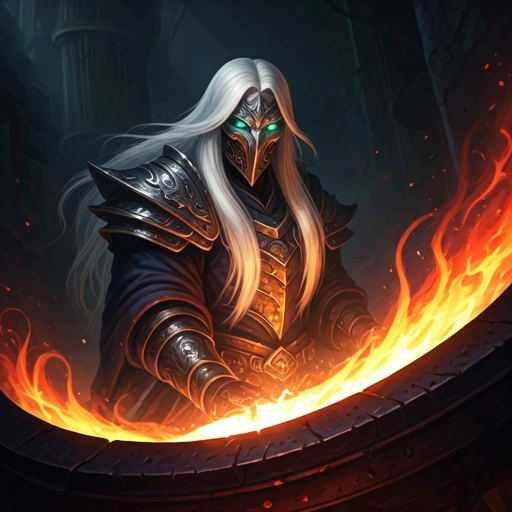
In the heart of the Celestial Forge, a mystical domain where nascent souls were born from stardust and cosmic energy, the Order of the Soulforgers acted as custodians of spiritual essence. They were not mere crafters of earthly materials, but rather manipulators of spiritual substance, entrusted with maintaining balance within the Forge by meticulously shaping and refining the developing souls, ensuring no soul remained trapped in imperfection or lost to the cosmic void. They believed that within each soul resided a singular spark of the divine, yearning for illumination. Among them was Elian, a young Soulforger, renowned for his intuitive understanding of the soul’s intricate language.
Yet, a growing unease stirred within Elian’s mind. He observed the Soulforgers carefully molding and burnishing the nascent souls, striving for a faultless form and discarding what they deemed as flaws. However, he questioned the fundamental nature of their work. Was their role simply to create immaculate souls, to mold them according to a preconceived pattern, or was there a deeper meaning to be found within the imperfections themselves, within the unique experiences and struggles that shaped each individual soul? He began to contemplate whether the true essence of a soul was forged in the crucible of its journey, through its encounters with both light and shadow.
One day, the Elder Soulforger, a being of profound stillness and ageless wisdom named Vulcanus, entrusted Elian with a unique and weighty task. He was to travel to the edge of the Celestial Forge, a region known as the “Shadow Anvil,” where a cluster of nascent souls had become trapped in a dense, inert energy field, hindering their complete formation. These souls, still in their nascent state, were burdened by unexpressed emotions, unresolved karmic connections, and forgotten links to the divine source. Vulcanus explained that this stagnation was not a natural event but a manifestation of unexpressed potential, suppressed experiences, and neglected connections with the divine. These lingering energies had coalesced into a heavy, stagnant shadow, preventing the souls from fully igniting their inner spark.
Elian embarked on his journey to the Shadow Anvil, a realm of subdued light and swirling cosmic dust, where the air felt heavy with unfulfilled potential. He realized he could not directly force the souls to form, as their dormancy reflected deeper, internal imbalances. Instead, he sought an innovative way to forge, using the very essence of the shadow itself – its density, its capacity to hold memories and experiences, its inherent connection to the light.
He manifested as a presence within the Shadow Anvil, adopting the name Orion, and found himself amidst a swirling panorama of cosmic dust, where the nascent souls drifted like faint embers. He perceived fragmented echoes of emotions – whispers of fear, cries of longing, fragments of love and loss – yet they were trapped within the shadow, almost imperceptible, like distant murmurs from a faded memory. He encountered no fully formed beings, only the nascent souls, their forms indistinct and their energies muted.
Orion observed that the souls’ stagnation stemmed from their disconnection from the divine source, from their inability to embrace the full spectrum of human experience, both light and shadow. They were trapped in a cycle of incomplete formation, their potential unable to find expression. They had forgotten the language of the divine spark within.
Rather than trying to banish the shadow, Orion sought to understand its purpose, recognizing the lessons it held for the nascent souls. He did not try to force them to conform to a predetermined ideal, but instead, he created a haven for them to experience the complete range of emotions and experiences, to confront their shadows and integrate them into their being. He became a “Soul Guide,” gently leading them through the process of self-discovery and helping them to ignite their inner spark.
He used gentle movements, focused intention, and profound listening to create patterns of resonance within the shadow, weaving threads of connection between the nascent souls and the divine source. He did not try to eliminate the imperfections or suppress the challenging emotions, but he assisted in contextualizing them, showing how they were vital parts of the soul’s journey.
As Orion spent time within the Shadow Anvil, a gradual, yet significant shift began to occur. The dormant shadow began to dissipate, replaced by a soft warmth and light. The fragmented echoes of emotions began to coalesce, forming more coherent expressions of the soul’s unique essence. The souls started to recall the language of the divine spark within.
One day, as Orion focused his intention on a particularly inert cluster of souls, visualizing their connection to the divine spark, a radiant luminescence began to emanate from within the shadow. It was not an abrupt explosion, but a measured unfolding, as the nascent souls began to ignite, their individual lights merging into a harmonious chorus.
Orion realized that the souls had not been externally shaped or perfected but had found their own unique form through the integration of their experiences, both light and shadow. Their journey of self-exploration was the genuine catalyst for their evolution, and their imperfections were as intrinsic as their perfections.
Orion returned to the Elder Soulforger, not with a tale of creating immaculate souls, but with a story of facilitating self-discovery and igniting the divine spark within. He had learned that the most profound forging was not about imposing an ideal, but about fostering an environment for authentic expression and allowing each soul to find its own singular path. He had come to understand that true growth arises not from the avoidance of difficulty, but from the courageous embrace of all experiences.
————
Interpretation:
This narrative, drawing inspiration from concepts of spiritual growth, karma, and the divine spark within, explores themes of self-discovery, acceptance, and the importance of embracing both light and shadow.
- The Nature of the Soul: The nascent souls represent the potential for spiritual development and the inherent divinity within each being.
- The Importance of Experience: The souls’ stagnation underscores the harmful effects of suppressing emotions and avoiding difficult experiences, impeding spiritual progress.
- The Power of Integration: Orion’s approach highlights the importance of embracing both light and shadow, integrating all aspects of the self to achieve wholeness.
- Self-Discovery and the Divine Spark: The souls’ ignition symbolizes the awakening of their inner potential and their connection to the divine source.
The story encourages reflection on our own spiritual journey, the significance of embracing all aspects of ourselves, and the power of experience to shape our growth. It suggests that true spiritual development comes not from striving for an impossible ideal, but from accepting our imperfections, learning from our experiences, and igniting the divine spark within.
